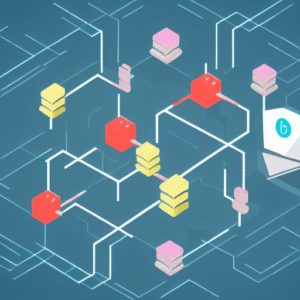Web 3.0, often stylized as Web3, is an evolving concept with practical implications for web architecture and internet users. The World Wide Web (web) is the application layer of linked resources that reside on the internet. Although there is no standardized definition, Web3 generally refers to a proposed decentralized architecture for the web, built on blockchain technologies, protocols, and applications such as cryptocurrencies. A blockchain is a digital database that records data on a decentralized network of computers, without central administration. Cryptocurrencies are a form of digital money without government backing that are exchanged through a blockchain network.
Since cryptocurrency developers adopted the term Web3 in 2014, it has garnered both support and criticism. Proponents claim it is a new web architecture that could displace existing “big tech” platforms as the primary means of accessing and storing data and content online, thereby improving individual user privacy. Critics argue Web3 is a buzzword that, if realized, would introduce new risks for users and simply replicate existing online power structures with new companies exerting control.
This In Focus provides an overview of the existing web architecture and development of Web3 applications. There are multiple “layers” of the internet, ranging from physical hardware to user applications. This In Focus examines Web3 at the application layer, through which most users interact with online content and services. It concludes with a brief discussion of some issues that may be of interest to Congress.
Web Architectures
Existing Web Architecture
There are two generations of the existing web: Web 1.0 (1990s) and Web 2.0 (2000s). Web 1.0 and Web 2.0 are not distinctly different web architectures, as Web 2.0 builds upon and augments Web 1.0. In both Web 1.0 and Web 2.0 architectures, users access a web browser installed on their computers to connect to hosting servers, retrieve information from webpages, and display content on their computers. This is called the “client-server model” since the client (web browser) requests and displays data from a server (a system that stores and processes information).
Web 1.0
In Web 1.0, the majority of web-based content consisted of static web pages, with interactivity often limited to hyperlinks and asynchronous commenting.
Web 2.0
Web 2.0 is characterized by platforms—the web-based interface and technical infrastructure that allows users to post content and interact with other users. These platforms enable connection to other sites, applications, and data, and allow developers to build and integrate other applications and services.
How Is Web3 Architecture Different?
While Web 1.0 and 2.0 use the client-server model, Web3 proposals would use a blockchain-based, “peer-to-peer” architecture. In a blockchain-based architecture, application code as well as data would be hosted across participating nodes in a distributed network rather than on servers operated by a company providing web applications or services, as is the case in Web 2.0. This would, proponents claim, address the concentration of services and data at current online platforms, eliminate intermediaries, and challenge existing business models. However, the technical feasibility and scalability of a fully decentralized, blockchain-based web architecture remain unproven.
Web3 Applications
Most users interact with the web primarily at the application layer. Some of the following blockchain applications have been proposed as part of a possible decentralized Web3 architecture.
Non-Fungible Tokens (NFTs)
NFTs are unique and noninterchangeable assets recorded on a blockchain that can be used to represent the ownership of physical or digital items. NFTs are commonly used to track the ownership of digital works (such as image, video, or music files), verify their authenticity, and enable their exchange. In a Web3 architecture, NFTs or cryptocurrencies could be used to purchase items online, represent digital ownership, pay royalties, or access certain applications and services.
Decentralized Applications (dApps)
dApps are applications that operate and run code on a blockchain network rather than the centralized servers of a company that provides a web application. Proponents believe Web3 dApps will replace existing centralized Web 2.0 platforms. Web3 users may be able to navigate among dApps using a blockchain-based identity or credentialing system. Developers of dApps may also attempt to incentivize user engagement through financial rewards in the form of cryptocurrencies or NFTs.
Decentralized Autonomous Organizations (DAOs)
DAOs are groups whose rules are encoded and transactions executed using a blockchain and automated computer programs, without intermediaries. Some existing Web3 proposals assert that users and online communities may interact and organize through DAOs. Membership may be determined by ownership of a specified “token,” such as a specific cryptocurrency or NFT. DAOs, alongside NFTs, dApps, and cryptocurrencies, may be used in Decentralized Finance (DeFi), which refers to the use of digital assets to deliver financial services through a blockchain network. Some proponents view DeFi as a central feature of Web3.
Does Web3 Already Exist?
Web3 proponents’ vision for an entirely decentralized online architecture has not been fully realized, but certain features associated with Web3 already exist. Many cryptocurrency, NFT, DeFi, and other Web3 companies have received significant funding from private venture capital firms. There are thousands of different cryptocurrencies and NFTs in existence, albeit some more actively traded than others. Certain DAOs and dApps, such as Decentraland, Axie Infinity, and OpenSea, are currently in operation. However, many of these applications and services have some centralization in platform decisionmaking and are only accessible through a web browser.
Since the concept of Web3 as a decentralized web is an amorphous and evolving concept, existing features, applications, and companies currently associated with it may not play a role in a more mature Web3 architecture. Additionally, some applications seen as cornerstones of Web3 may be developed by Web 2.0 companies, operate in tandem with Web 2.0 services, or be adopted and integrated into Web 2.0 platforms.
Support for Web3
Web3 has developed alongside, and in response to, concerns about centralized tech platforms and their implications for user privacy, data ownership, and data security. Supporters believe Web3 applications and services will not be owned by a central company or authority, but rather by users, who will earn ownership tokens by contributing to the development and maintenance of the services. Users could potentially monetize their web activity by receiving cryptocurrencies and other tokens as a reward for posting, sharing, or leaving reviews for products and services. These tokens may in turn grant membership to DAOs, access to dApps, or voting rights on Web3 companies’ actions. Proponents argue this structure could democratize data ownership and decrease the power of centralized Web 2.0 companies.
Criticism of Web3
Proponents of Web3 highlight its intended decentralization; however, a small number of companies associated with Web3 have accrued large market share, leading to the criticism that Web3 shifts centralization to different hands. Some critics claim that Web3 companies might simply take the place of Web 2.0 platforms as business models change, retaining the same authority over content, transactions, terms and conditions, and technical decisions.
Critics also argue that Web3 represents a shift to a “token economy” where the need to exchange cryptocurrencies and NFTs for most interactions and transactions results in the “financialization of everything.” Tokens or cryptocurrencies may be required to access certain Web3 platforms, creating services that are closed off to users unless they meet certain financial conditions. Web3 companies typically profit through the issuance and appreciation of their tokens. If a token value decreases, it may imperil the viability of their business, so companies may have an incentive to generate transactions. Prominent critics, such as Twitter co-founder Jack Dorsey and Signal co-founder Moxie Marlinspike, argue there is centralization around certain cryptocurrency exchanges, digital wallet providers that allow a user to store tokens, and NFT marketplaces—many of which are funded by the same small circle of venture capital firms. As part of their investment, venture capital firms may receive a Web3 project’s cryptocurrency, NFT, or special “governance token,” which grants the right to vote on a project’s development. This structure may incentivize investors to use votes to prioritize a project’s token value over other interests, mirroring some current criticism of “big tech” companies prioritizing stock value over user interests. Investors may also be incentivized to create hype around a project to attract other investors, inflate token value, and then cash out, precipitating a massive price drop.
Considerations for Congress
Depending on how Web3 develops, it could mitigate some of the existing issues associated with Web 2.0 or introduce new privacy, security, and financial risks that could raise questions of interest for Congress.
Oversight Without Centralized Authority
A fully decentralized Web3 architecture may make regulatory compliance difficult if decision making authorities are distributed and require multi-party cooperation. Regulatory frameworks for existing blockchain-based applications, such as cryptocurrencies and other tokens, are nascent. Their development may shape how Web3 application governance structures evolve. It is also currently unclear how Web3 platforms might address content moderation, consumer safety, and fraud. Most Web 2.0 platforms can directly implement protections and ensure compliance with existing regulations through corporate ownership and executive management structures. Congress may consider what agencies, if any, should play a role in Web3 oversight.
Privacy and Security
Decentralized blockchain networks and Web3 applications may create new security risks. Cryptocurrency, NFT, and DAO scams have become common, and the anonymity of many Web3 developers and users complicates remediation. If digital wallets are hacked or encryption algorithms broken, users may be unable to access applications, accounts, or services. Most blockchains are immutable, meaning records cannot be changed once added. If personally identifiable information or sensitive data are stored on a blockchain, users may be unable to correct these records if there are errors or falsifications. Congress may consider whether existing privacy and consumer protections adequately address these risks.
Energy Consumption
Some Web3 platforms are built on energy-intensive blockchains, with the largest blockchain networks consuming as much energy as small nations. Congress has previously conducted oversight of energy-intensive cryptocurrencies, and may consider how Web3 will increase future blockchain energy consumption.
Organization: Congressional Research Service
Author: Kristen E. Busch, Analyst in Science and Technology Policy
Publication Date: April 1, 2022
Disclaimer
This document was prepared by the Congressional Research Service (CRS). CRS serves as nonpartisan shared staff to congressional committees and Members of Congress. It operates solely at the behest of and under the direction of Congress. Information in a CRS Report should not be relied upon for purposes other than public understanding of information that has been provided by CRS to Members of Congress in connection with CRS’s institutional role. CRS Reports, as a work of the United States Government, are not subject to copyright protection in the United States. Any CRS Report may be reproduced and distributed in its entirety without permission from CRS. However, as a CRS Report may include copyrighted images or material from a third party, you may need to obtain the permission of the copyright holder if you wish to copy or otherwise use copyrighted material.
Related Articles

Moralis Academy Review: Everything You Need to Know
Explore our comprehensive review of Moralis Academy, a leading education platform specializing in blockchain and Web3 technologies. In this article, you will gain insight into its courses, costs, and how it can bolster your career in the thriving blockchain industry.

101 Blockchains: Pricing Plans 2023
This article provides an overview of 101 Blockchains’ prices, subscription plans, courses, reviews, coupons, discounts, alternatives, and more!

Blockchain vs. DeFi
Wondering what the similarities and differences are between blockchain and decentralized finance (DeFi)? We break it down for you in this article.
